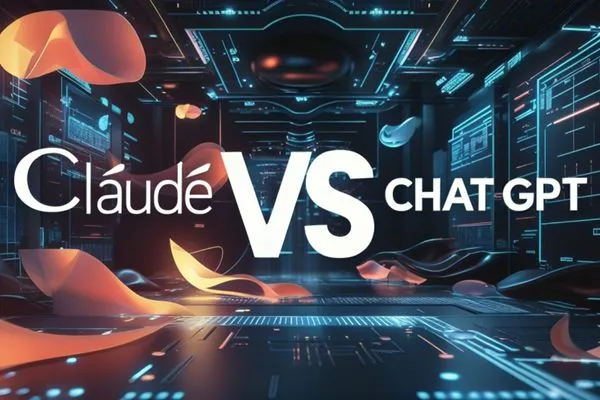Claude AI and ChatGPT have emerged as frontrunners in conversational agents in the rapidly evolving landscape of artificial intelligence. When considering Claude AI vs ChatGPT, it’s clear both are designed to facilitate human-like interactions but have distinct features and capabilities. This article delves into Claude AI, how it operates, and how it compares to ChatGPT.
Understanding Claude AI
Claude AI is a conversational AI model developed by Anthropic, a company founded by former OpenAI employees. After Claude Shannon, the father of information theory, Claude AI aims to create a more ethical and user-friendly AI experience. Its design philosophy emphasizes safety, interpretability, and alignment with human values.
Key Features of Claude AI
- Safety and Alignment
Claude AI is built to minimize harmful outputs and ensure that its responses align with user intentions. This is particularly important in applications where misinformation or harmful content could have serious consequences.
- User-Centric Design
The model is designed to be intuitive, making it easier for users to interact with and understand its capabilities. This user-friendly approach is crucial for widespread adoption, especially among non-technical users.
- Multi-Turn Conversations
Claude AI maintains context over extended conversations, allowing for more natural interactions. This capability is essential for applications like customer support, where understanding the context of previous interactions can significantly enhance user experience.
- Ethical Considerations
Claude AI incorporates ethical guidelines into its training process to reduce biases and ensure that the AI behaves consistently with societal values. This focus on ethics is becoming increasingly important as AI systems are deployed in sensitive areas such as healthcare and education.
Technical Architecture of Claude AI
Claude AI is built on advanced neural network architectures that allow it to process and generate human-like text. The model leverages transformer technology, which has become the standard for natural language processing tasks. This architecture enables Claude AI to understand context, generate coherent responses, and adapt to various conversational styles.
What Is ChatGPT?
ChatGPT, developed by OpenAI, is another powerful conversational AI model that has gained significant popularity. It is based on the GPT (Generative Pre-trained Transformer) architecture and is designed to generate human-like text based on the input it receives.
Key Features of ChatGPT
- Versatility
ChatGPT can handle various topics, from casual conversations to technical discussions. This versatility makes it suitable for multiple applications, including chatbots, content creation, and educational tools.
- Rich Contextual Understanding
The model is trained on diverse datasets, enabling it to understand and generate contextually relevant responses. This capability is crucial for maintaining engaging and informative conversations.
- Customization
Users can fine-tune ChatGPT for specific applications, making it adaptable for various use cases. This customization allows businesses to tailor the AI’s responses to align with their brand voice and customer needs.
- Continuous Learning
OpenAI has implemented mechanisms for ChatGPT to learn from user interactions, allowing it to improve over time. This constant learning process helps the model stay relevant and effective in its responses.
Technical Architecture of ChatGPT
ChatGPT is built on the GPT architecture, which utilizes a transformer model to process text. The model is pre-trained on a vast corpus of text data, allowing it to learn grammar, facts, and some reasoning abilities. After pre-training, it undergoes fine-tuning on specific tasks, enhancing its performance in conversational contexts.
Comparing Claude AI and ChatGPT
To better understand the differences and similarities between Claude AI and ChatGPT, let’s break down their features in a comparative table:
Performance Metrics
When comparing AI models, performance metrics are crucial. These metrics can include:
- Response Accuracy
Measured by how accurately the model answers questions or provides information. Benchmarks often involve standardized datasets for evaluation.
- Relevance
User feedback and expert reviews are often used to assess the degree to which the responses are pertinent to the user’s queries.
- Engagement
How well the model maintains user interest during interactions can be gauged through user retention rates and interaction length.
- Safety
The model’s effectiveness in avoiding harmful or biased outputs is evaluated through rigorous testing and user reports.
Both Claude AI and ChatGPT have been evaluated on these metrics, with Claude AI often scoring higher in safety and alignment due to its ethical design principles.
Use Cases for Claude AI and ChatGPT
Claude AI:
- Customer Support
Claude AI can be integrated into customer service platforms to provide safe and effective responses to user inquiries. Its focus on ethical interactions makes it suitable for handling sensitive customer issues.
- Educational Tools
Its user-centric design makes it suitable for academic applications, helping students with queries in a safe environment. Claude AI can assist in tutoring, providing explanations, and answering questions in a way that aligns with educational standards.
- Mental Health Support
Given its emphasis on safety, Claude AI can be utilized in mental health applications, offering supportive conversations and resources while minimizing the risk of harmful advice.
ChatGPT:
- Content Creation:
ChatGPT is widely used for generating articles, blogs, and creative writing. Its versatility allows writers to brainstorm ideas, draft content, and edit existing work.
- Programming Assistance:
Developers utilize ChatGPT for coding help, debugging, and generating code snippets. Its ability to understand technical queries makes it a valuable tool for programmers.
- Interactive Storytelling:
ChatGPT can be employed in gaming and interactive storytelling. It generates dialogue and plot developments based on user choices, enhancing the gaming experience.
- Language Translation:
While not its primary function, ChatGPT can assist in translating text between languages, making it a valuable tool for multilingual communication.
Ethical Considerations in AI
As AI technology continues to advance, ethical considerations become increasingly important. Both Claude AI and ChatGPT have made strides in addressing these concerns, but they approach them differently.
Claude AI’s Ethical Framework:
Claude AI is designed with a strong ethical framework that prioritizes user safety and alignment with human values. This includes:
- Bias Mitigation
The model is trained to recognize and minimize biases in its responses, ensuring that it does not perpetuate harmful stereotypes or misinformation.
- Transparency
Claude AI aims to be transparent about its capabilities and limitations, helping users understand how to interact with it effectively.
- User Control
Users have more control over the interactions, allowing them to guide the conversation and set boundaries for the AI’s responses.
ChatGPT’s Ethical Improvements:
OpenAI has also made significant efforts to enhance the ethical considerations of ChatGPT:
- Feedback Mechanisms
OpenAI encourages user feedback to identify and rectify harmful outputs, continuously improving the model’s safety.
- Content Moderation
ChatGPT incorporates moderation techniques to filter out inappropriate or harmful content, making it safer for general use.
- Research and Collaboration
OpenAI collaborates with researchers and organizations to study the societal impacts of AI, ensuring that its developments align with ethical standards.
Future Developments
The future of conversational AI is promising, with both Claude AI and ChatGPT poised for further advancements. Here are some potential developments to watch for:
Claude AI:
- Enhanced Personalization
Future iterations of Claude AI may focus on deeper personalization, allowing the model to adapt its responses based on individual user preferences and histories.
- Broader Applications
As the model matures, it may find applications in more specialized fields, such as legal advice and healthcare consultations.
- Integration with Other Technologies
Claude AI could be integrated with other emerging technologies, such as augmented reality (AR) and virtual reality (VR), to create immersive conversational experiences.
ChatGPT:
- Improved Contextual Awareness
Future versions of ChatGPT may enhance its ability to maintain context over extended conversations, making interactions more fluid and natural.
- Multimodal Capabilities
OpenAI explores integrating multimodal capabilities, allowing ChatGPT to process and generate text, images, audio, and video.
- Global Language Support
Expanding language support will make ChatGPT more accessible to non-English speakers, broadening its user base and applications.
Conclusion:
Claude AI and ChatGPT represent significant conversational AI advancements, each with unique strengths. Claude AI prioritizes safety and user alignment, making it an excellent choice for applications requiring ethical considerations. On the other hand, ChatGPT offers versatility and rich contextual understanding, making it suitable for a broader range of tasks.
As AI technology evolves, the competition between these models will likely drive further innovations, ultimately benefiting users and businesses. Whether you choose Claude AI or ChatGPT will depend on your specific needs and the context in which you plan to use these powerful tools.
By understanding the nuances of each model, you can make an informed decision that aligns with your goals in the ever-changing world of artificial intelligence. As we look to the future, the potential for these technologies to enhance our lives and work is immense, paving the way for a more connected and intelligent world.
FAQs:
Q1. What is Claude AI?
Claude AI is a conversational AI model developed by Anthropic. It focuses on safety, ethical considerations, and user-friendly interactions. It aims to provide coherent and contextually relevant responses while minimizing harmful outputs.
Q2. How does Claude AI differ from ChatGPT?
While both are conversational AI models, Claude AI emphasizes safety and ethical alignment, whereas ChatGPT is known for its versatility and rich contextual understanding. Claude AI is designed to minimize harmful outputs, while ChatGPT excels in handling various topics.
Q3. What are the primary use cases for Claude AI?
Claude AI is primarily used in customer support, educational tools, and mental health applications. Its focus on safety makes it suitable for sensitive interactions.
Q4. Can ChatGPT be customized for specific applications?
ChatGPT can be fine-tuned for various applications, allowing businesses to tailor its responses to align with their brand voice and customer needs.
Q5. How do both models handle ethical considerations?
Claude AI incorporates ethical guidelines into its training process to minimize biases and ensure alignment with human values. ChatGPT has implemented feedback mechanisms and content moderation techniques to improve safety and reduce harmful outputs.
Q6. What are the future developments expected for these AI models?
Future developments may include enhanced personalization for Claude AI, improved contextual awareness for ChatGPT, and integration of multimodal capabilities, allowing both models to process and generate various types of content.
Q7. Which AI model is better for content creation?
ChatGPT is often preferred for content creation due to its versatility and ability to generate coherent and engaging text across various topics. However, Claude AI can also be used effectively in specific contexts where safety and ethical considerations are paramount.
Q8. Are there any limitations to using Claude AI or ChatGPT?
Both models have limitations. Claude AI may be less versatile in handling a wide range of topics than ChatGPT, while ChatGPT may occasionally produce less safe or biased outputs despite ongoing improvements.
Citations and Sources
-
- Anthropic. Claude AI (Retrieved February 28, 2025)
- OpenAI. ChatGPT (Retrieved February 28, 2025)
- Research Papers:
- Brown, T. B., Mann, B., Ryder, N., Subbiah, M., Kaplan, J., Dhariwal, P., … & Amodei, D. (2020). “Language Models are Few-Shot Learners.” Link to Paper (Retrieved February 28, 2025)
- Kaplan, J., McCandlish, S., Henighan, T., Wu, T., & Amodei, D. (2020). “Scaling Laws for Neural Language Models.” Link to Paper (Retrieved February 28, 2025)
- Jobin, A., Ienca, M., & Andorno, R. (2019). “Ethics of AI: A Systematic Literature Review.” Link to Paper (Retrieved February 28, 2025)










